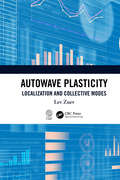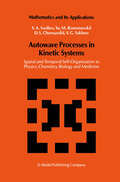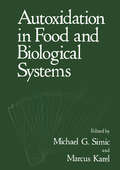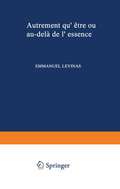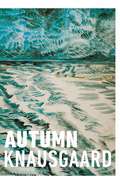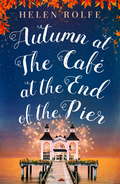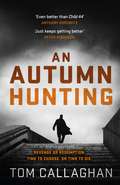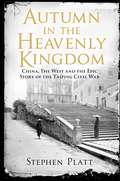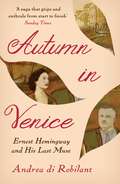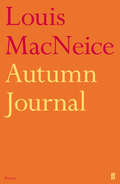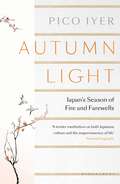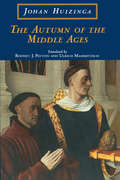- Table View
- List View
Autowave Plasticity: Localization and Collective Modes
by Lev ZuevAutowave Plasticity: Localization and Collective Modes discusses the nature of plastic flow in solids associated with the development of a localized plastic flow. Written by an authority in the field, the author demonstrates how patterns of localized plastic flow are associated with autowave modes that are generated in a deformable sample and delivers a complete work on the subject. Key Features An original work on the nature of plastic flows in solids, particularly metals and crystals Focuses on plastic flow as an autowave process Contains elements of theories, experimental considerations, and numerical modeling This reference will help readers with creating experimental methods to observe or localize plastic flow and with the modeling of plastic flows. It is a valuable reference for graduate students and research specialists working in material science.
Autowave Plasticity: Localization and Collective Modes
by Lev ZuevAutowave Plasticity: Localization and Collective Modes discusses the nature of plastic flow in solids associated with the development of a localized plastic flow. Written by an authority in the field, the author demonstrates how patterns of localized plastic flow are associated with autowave modes that are generated in a deformable sample and delivers a complete work on the subject. Key Features An original work on the nature of plastic flows in solids, particularly metals and crystals Focuses on plastic flow as an autowave process Contains elements of theories, experimental considerations, and numerical modeling This reference will help readers with creating experimental methods to observe or localize plastic flow and with the modeling of plastic flows. It is a valuable reference for graduate students and research specialists working in material science.
Autowave Processes in Kinetic Systems: Spatial and Temporal Self-Organisation in Physics, Chemistry, Biology, and Medicine (Mathematics and its Applications #11)
by V.A. Vasiliev Yu.M. Romanovskii D.S. Chernavskii V.G. YakhnoProbably, we are obliged to Science, more than to any other field of the human activity, for the origin of our sense that collective efforts are necessary indeed. F. Joliot-Curie The study of autowave processes is a young science. Its basic concepts and methods are still in the process of formation, and the field of its applications to various domains of natural sciences is expanding continuously. Spectacular examples of various autowave processes are observed experimentally in numerous laboratories of quite different orientations, dealing with investigations in physics, chemistry and biology. It is O1). r opinion, however, that if a history of the discovery of autowaves will he written some day its author should surely mention three fundamental phenomena which were the sources of the domain in view. "Ve mean combustion and phase transition waves, waves in chemical reactors where oxidation-reduction processes take place, and propagation of excitations in nerve fibres. The main tools of the theory of autowave processes are various methods used for investigating nonlinear discrete or distributed oscillating systems, the mathe matical theory of nonlinear parabolic differential equations, and methods of the theory of finite automata. It is noteworthy that the theory of autowave,. , has been greatly contributed to be work of brilliant mathematicians who anticipated the experimental discoveries in their abstract studies. One should mention R. Fishel' (1937), A. N. Kolmogorov, G. 1. Petrovskii, and N. S. Piskunov (1937), N. Wiener and A. Rosenbluth (1946), A. Turing (1952).
Autoxidation in Food and Biological Systems
by M. G. Simic Marcus KarelThe material presented in this book deals with basic mechanisms of free radical reactions in autoxidation processes and anitoxidant suppression of autoxidation of foods, biochemical models and biologi cal systems. Autoxidation in foods and corresponding biological effects are usually approached separately although recent mechanistic developments in the biochemistry and free radical chemistry of per oxides and their precursors tend to bring these two fields closer. Apparent ability of antioxidants in diets to reduce the inci dence of cancer has resulted in scrutiny of autoxidized products and their precursors as possibly toxic, mutagenic and carcinogenic agents. Mechanisms of any of these effects have been barely ad dressed. Yet we know now that free radicals, as esoteric as they were only a few decades ago, are being discovered in foods, biochem ical and biological systems and do play a role in the above-mentioned causalities. The purpose of the Workshop and the resulting book was to give a unifying approach towards study of beneficial and deleterious effects of autoxidation, based on rigorous scientific considerations. It is our hope that the material presented in this book will not only provide a review of the "state of the art" of autoxidation and anti oxidants, but also reflect the interaction which occurred during the Workshop between workers using model sytems, and food and biological systems.
AutPlay Therapy for Children and Adolescents on the Autism Spectrum: A Behavioral Play-Based Approach, Third Edition
by Robert Jason GrantAutPlay Therapy is a behavioral play-based treatment approach to working with children and adolescents with autism spectrum disorder and other developmental disabilities. This innovative new model contains a parent-training component (wherein the therapist trains parents to do directive play therapy interventions in the home) and can be utilized in any setting where children and adolescents with an autism disorder, ADHD, dysregulation issues, or other neurodevelopmental disorders are treated. This comprehensive resource outlines the AutPlay Therapy process and offers a breakdown of treatment phases along with numerous assessment materials and over 30 directive play therapy techniques.
AutPlay Therapy for Children and Adolescents on the Autism Spectrum: A Behavioral Play-Based Approach, Third Edition
by Robert Jason GrantAutPlay Therapy is a behavioral play-based treatment approach to working with children and adolescents with autism spectrum disorder and other developmental disabilities. This innovative new model contains a parent-training component (wherein the therapist trains parents to do directive play therapy interventions in the home) and can be utilized in any setting where children and adolescents with an autism disorder, ADHD, dysregulation issues, or other neurodevelopmental disorders are treated. This comprehensive resource outlines the AutPlay Therapy process and offers a breakdown of treatment phases along with numerous assessment materials and over 30 directive play therapy techniques.
The AutPlay® Therapy Handbook: Integrative Family Play Therapy with Neurodivergent Children
by Robert Jason GrantThe AutPlay® Therapy Handbook provides a thorough explanation and understanding of AutPlay® Therapy (an integrative family play therapy framework) and details how to effectively implement AutPlay® Therapy for addressing the mental health needs of autistic and neurodivergent children and their families. This handbook guides the mental health therapist working with children and adolescents through their natural language of play. Opening with an extensive review of the neurodiversity paradigm and ableism, the chapters cover AutPlay® Therapy protocol, phases of therapy, assessment strategies, and common need areas along with understanding neurodiversity affirming processes. Additional chapters highlight the therapeutic powers of play, integrative play therapy approaches, understanding co-occurring conditions, working with high support needs, and using AutPlay® Therapy to address regulation, sensory, social/emotional, and other mental health concerns that neurodivergent children may be experiencing. The handbook serves as a thorough guide for play therapists, child therapists, and family therapists who work with neurodivergent children and their families.
The AutPlay® Therapy Handbook: Integrative Family Play Therapy with Neurodivergent Children
by Robert Jason GrantThe AutPlay® Therapy Handbook provides a thorough explanation and understanding of AutPlay® Therapy (an integrative family play therapy framework) and details how to effectively implement AutPlay® Therapy for addressing the mental health needs of autistic and neurodivergent children and their families. This handbook guides the mental health therapist working with children and adolescents through their natural language of play. Opening with an extensive review of the neurodiversity paradigm and ableism, the chapters cover AutPlay® Therapy protocol, phases of therapy, assessment strategies, and common need areas along with understanding neurodiversity affirming processes. Additional chapters highlight the therapeutic powers of play, integrative play therapy approaches, understanding co-occurring conditions, working with high support needs, and using AutPlay® Therapy to address regulation, sensory, social/emotional, and other mental health concerns that neurodivergent children may be experiencing. The handbook serves as a thorough guide for play therapists, child therapists, and family therapists who work with neurodivergent children and their families.
AutPlay® Therapy Play and Social Skills Groups: A 10-Session Model
by Robert Jason Grant Tracy Turner-BumberryAutPlay® Therapy Play and Social Skills Groups provides practitioners with a step-by-step guide for implementing a social skills group to help children and adolescents with autism improve on their play and social skills deficits in a fun and engaging way. This unique 10-session group model incorporates the AutPlay Therapy approach focused on relational and behavioral methods. Group setup, protocol, and structured play therapy interventions are presented and explained for easy implementation by professionals. Also included are parent implemented interventions that allow parents and/or caregivers to become co-change agents in the group process and learn how to successfully implement AutPlay groups. Any practitioner or professional who works with children and adolescents with autism spectrum disorder will find this resource to be a unique and valuable guide to effectively implementing social skills groups.
AutPlay® Therapy Play and Social Skills Groups: A 10-Session Model
by Robert Jason Grant Tracy Turner-BumberryAutPlay® Therapy Play and Social Skills Groups provides practitioners with a step-by-step guide for implementing a social skills group to help children and adolescents with autism improve on their play and social skills deficits in a fun and engaging way. This unique 10-session group model incorporates the AutPlay Therapy approach focused on relational and behavioral methods. Group setup, protocol, and structured play therapy interventions are presented and explained for easy implementation by professionals. Also included are parent implemented interventions that allow parents and/or caregivers to become co-change agents in the group process and learn how to successfully implement AutPlay groups. Any practitioner or professional who works with children and adolescents with autism spectrum disorder will find this resource to be a unique and valuable guide to effectively implementing social skills groups.
Autumn: (Seasons Quartet 1) (Seasons Quartet #1)
by Karl Ove Knausgaard Vanessa Baird Ingvild BurkeyThe Sunday Times Top Ten BestsellerThe New York Times BestsellerFrom the author of the monumental My Struggle series, Karl Ove Knausgaard, one of the masters of contemporary literature and a genius of observation and introspection, comes the first in a new autobiographical quartet based on the four seasonsI want to show you our world as it is now: the door, the floor, the water tap and the sink, the garden chair close to the wall beneath the kitchen window, the sun, the water, the trees. You will come to see it in your own way, you will experience things for yourself and live a life of your own, so of course it is primarily for my own sake that I am doing this: showing you the world, little one, makes my life worth living. Autumn begins with a letter Karl Ove Knausgaard writes to his unborn daughter, showing her what to expect of the world. He writes one short piece per day, describing the material and natural world with the precision and mesmerising intensity that have become his trademark. With acute sensitivity he describes daily life with his wife and children in rural Sweden, drawing upon memories of his own childhood to give an inimitably tender perspective on the precious and unique bond between parent and child. Nothing is too small or too vast to escape his attention; this is a personal encyclopaedia on everything from chewing gum to the stars. Beautifully illustrated by Vanessa Baird, this tender and deeply personal book is the first of four volumes marvelling at the vast, unknowable universe around us.
Autumn at the Café at the End of the Pier: Part Three
by Helen RolfeLooking for love this autumn? You'll find it at The Café at the End of the Pier... A feelgood novella and the continuation of the Café at the End of the Pier series.Autumn brings golden leaves and crisp days to Salthaven-on-Sea - but inside the Cafe the lights are glowing, the hot chocolate is warming, and romantic sparks are flying... Jo has found her place at the heart of the seaside community, her blind dates are fizzing with chemistry, and this season she plans to bring young and old together with her pumpkin-carving event. But Jo must also find a way to heal the rifts in her own family, even if it means facing up to some home truths.With the mystery of Jo's own secret admirer to unravel, there are bound to be fireworks this bonfire night at The Cafe at the End of the Pier...A perfect heartwarming read, for fans of Debbie Johnson and Cathy Bramley***Readers love The Cafe at the End of the Pier series:'A beautifully written feel-good story that will make you smile''Loved the characters and couldn't wait to turn the page''What an absolute delight!'
An Autumn Hunting
by Tom Callaghan'Even better than Child 44. Akyl Borubaev is a terrific creation' Anthony Horowitz'Just keeps getting better . . . buy the whole series right away' Peter Robinson, No.1 bestselling author of Sleeping in the GroundNo sooner has Akyl Borubaev been reinstated as an Inspector in the Bishkek Murder Squad than he's suspended for alleged serious crimes against the state. After an attempted assassination of a prominent minister goes spectacularly wrong, Akyl is a fugitive from his former colleagues and involved with one of Kyrgyzstan's most dangerous criminals. On the run, caught up in a illegal scheme that can only end badly, it's time for Akyl to take a stand for everything he believes in.
Autumn in the Heavenly Kingdom: China, The West and the Epic Story of the Taiping Civil War
by Stephen R. PlattIn the early 1850s, during the waning years of the Qing dynasty, word spread of a major revolution brewing in the provinces. The leader of the this movement - who called themselves the Taiping - was Hong Xiuquan, a failed civil servant who claimed to be the son of God and the brother of Jesus Christ. As the revolt grew and battles raged across the empire, all signs pointed to a Taiping victory and to the inauguration of a modern, industrialized and pro-Western china. Soon, however, Britain and the United States threw their support behind the Qing, soon quashing the Taiping and rendering ineffective the years of bloodshed the revolution had endured. In Autumn in the Heavenly Kingdom, Stephen Platt recounts the events of the rebellion and its suppression in spellbinding detail. It is an essential and enthralling history of the rise and fall of a movement that, a century and a half ago, might have launched China into the modern world.
Autumn in Venice: Ernest Hemingway and His Last Muse
by Andrea di RobilantNational Geographic Traveller's the best books on European cities, 2019In the autumn of 1948 Hemingway was approaching fifty and hadn't published a novel in nearly a decade. He travelled for the first time to Venice and there, at a duck shoot in the lagoon he met and fell in love with Adriana Ivancich, a striking young Venetian woman just out of finishing school. What followed was a platonic love affair; he continued to visit her in Venice; she in turn came to Cuba while he wrote The Old Man and the Sea. This is the illuminating story of a writer and a muse that intimately examines both the cost to Adriana and the fractured heart and changing art of Hemingway in his fifties.'Hemingway [is] an enduringly fascinating character, one whom di Robilant, with his easy-paced style, has sympathetically brought to life.' Literary Review'Effortlessly and expertly explores the secret desires, successes, and depressive obstacles that shrouded Ernest Hemingway's final productive years.' New York Journal of Books
Autumn Journal: Poem (Faber Poetry Ser.)
by Louis MacNeiceWritten between August and December 1938, Autumn Journal is still considered one of the most valuable and moving testaments of living through the thirties by a young writer. It is a record of the author's emotional and intellectual experience during those months, the trivia of everyday living set against the events of the world outside, the settlement in Munich and slow defeat in Spain.
Autumn Leaves at Mill Grange: a feelgood, cosy autumn romance (The Mill Grange Series)
by Jenny Kane'I am a big fan of Jenny Kane' Katie Fforde. Welcome back to Mill Grange and the beautiful village of Upwich, full of larger-than-life characters you can't help but adore.Sam Philips' time in the forces changed him forever. Supported by his friends, Sam is keen to help make beautiful Mill Grange a safe retreat for injured army personnel... but his crippling claustrophobia means Sam is living in a tent on the grounds! Enlisting the help of charming village stalwarts Bert and Mabel Hastings, Tina Martins is determined to find a way to help him conquer his fears. But why does she feel like he is keeping a secret?Having helped Thea Thomas restore Mill Grange over the summer, celebrity archaeologist, Shaun Cowlson has left Exmoor to film for his Landscape Treasures show in Cornwall. Despite being busy with an unexpected archaeological project of her own, Thea can't help but miss his company. Especially as someone else is vying for his attention...Readers love Autumn Leaves at Mill Grange! 'Loved loved this book!... This book was brilliant!... I am blown away... I hope that there is going to be a sequel with this exceptional family of characters because I will buy it!' NetGalley Reviewer, ?????'Absolutely loved this story... Compulsive. I highly recommended this start to a new series from Jenny Kane... Flawless' Carol McGrath, ?????'I loved this charming story and found it hard to put down. It was full of brilliant characters and a really interesting plot lines and kept my attention throughout' Goodreads Reviewer, ?????'Like coming home to old friends' NetGalley Reviewer, ?????'My Kindle wasn't exactly glued to my hand but it might as well have been because it travelled everywhere with me... Couldn't stop reading... A very well deserved 5* out of 5*' Ginger Book Geek, ?????'Heart-warming, emotional and wonderfully uplifting, it's impossible not to fall under Jenny Kane's spell with her cosy and addictive new novel' Goodreads Reviewer, ?????'Another hit in the series. Continues where the first one ended... One of my favorites. Highly recommend this book' NetGalley Reviewer, ?????'Plenty of laughs and advice from unlikely corners, I can't wait for the next installment' NetGalley Reviewer, ?????
Autumn Light: Japan's Season of Fire and Farewells
by Pico IyerFor decades now, Pico Iyer has been based for much of the year in Nara, Japan, where he and his Japanese wife, Hiroko, share a two-room apartment. But when his father-in-law dies suddenly, calling him back to Japan earlier than expected, Iyer begins to grapple with the question we all have to live with: how to hold on to the things we love, even though we know that we and they are dying.In a country whose calendar is marked with occasions honouring the dead, this question has a special urgency and currency. Iyer leads us through the autumn following his father-in-law's death, introducing us to the people who populate his days: his ailing mother-in-law, who often forgets that her husband has died; his absent brother-in-law, who severed ties with his family years ago but to whom Hiroko still writes letters; and the men and women in his ping-pong club, who, many years his senior, traverse their autumn years in different ways. And as the maple leaves begin to redden and the heat begins to soften, Iyer offers us a singular view of Japan, in the season that reminds us to take nothing for granted.
Autumn Moon Poems
by J P DasThis anthology presents some of Gulzar's most significant Urdu works in translation for the first time. Autumn Moon is a reflection of Gulzar's penchant for the sublime. He is one of the most versatile Urdu poets on the scene today. The poems in this seminal collection, Autumn Moon, are a deep exploration of love, longing, passion, ecstasy, absence and loss.
The Autumn of Dictatorship: Fiscal Crisis and Political Change in Egypt under Mubarak (Stanford Studies in Middle Eastern and Islamic Societies and Cultures #82)
by Samer SolimanThe Egyptian protests in early 2011 took many by surprise. In the days immediately following, commentators wondered openly over the changing situation across the Middle East. But protest is nothing new to Egypt, and labor activism and political activism, most notably the Kifaya (Enough) movement, have increased dramatically over recent years. In hindsight, it is the durability of the Mubarak regime, not its sudden loss of legitimacy that should be more surprising. Though many have turned to social media for explanation of the events, in this book, Samer Soliman follows the age-old adage—follow the money. Over the last thirty years, the Egyptian state has increasingly given its citizens less money and fewer social benefits while simultaneously demanding more taxes and resources. This has lead to a weakened state—deteriorating public services, low levels of law enforcement, poor opportunities for employment and economic development—while simultaneously inflated the security machine that sustains the authoritarian regime. Studying the regime from the point of view of its deeds rather than its discourse, this book tackles the relationship between fiscal crisis and political change in Egypt. Ultimately, the Egyptian case is not one of the success of a regime, but the failure of a state. The regime lasted for 30 years because it was able to sustain and reproduce itself, but left an increasingly weakened state, unable to facilitate capitalist development in the country. The resulting financial crisis profoundly changed the socio-economic landscape of the country, and now is paving the way for political change and the emergence of new social forces.
The Autumn of the Middle Ages
by Johan Huizinga"Here is the first full translation into English of one of the 20th century's few undoubted classics of history." —Washington Post Book World The Autumn of the Middle Ages is Johan Huizinga's classic portrait of life, thought, and art in fourteenth- and fifteenth-century France and the Netherlands. Few who have read this book in English realize that The Waning of the Middle Ages, the only previous translation, is vastly different from the original Dutch, and incompatible will all other European-language translations. For Huizinga, the fourteenth- and fifteenth-century marked not the birth of a dramatically new era in history—the Renaissance—but the fullest, ripest phase of medieval life and thought. However, his work was criticized both at home and in Europe for being "old-fashioned" and "too literary" when The Waning of the Middle Ages was first published in 1919. In the 1924 translation, Fritz Hopman adapted, reduced and altered the Dutch edition—softening Huizinga's passionate arguments, dulling his nuances, and eliminating theoretical passages. He dropped many passages Huizinga had quoted in their original old French. Additionally, chapters were rearranged, all references were dropped, and mistranslations were introduced. This translation corrects such errors, recreating the second Dutch edition which represents Huizinga's thinking at its most important stage. Everything that was dropped or rearranged has been restored. Prose quotations appear in French, with translations preprinted at the bottom of the page, mistranslations have been corrected. "The advantages of the new translation are so many. . . . It is one of the greatest, as well as one of the most enthralling, historical classics of the twentieth century, and everyone will surely want to read it in the form that was obviously intended by the author." —Francis Haskell, New York Review of Books "A once pathbreaking piece of historical interpretation. . . . This new translation will no doubt bring Huizinga and his pioneering work back into the discussion of historical interpretation." —Rosamond McKitterick, New York Times Book Review
The Autumn of the Middle Ages
by Johan Huizinga"Here is the first full translation into English of one of the 20th century's few undoubted classics of history." —Washington Post Book World The Autumn of the Middle Ages is Johan Huizinga's classic portrait of life, thought, and art in fourteenth- and fifteenth-century France and the Netherlands. Few who have read this book in English realize that The Waning of the Middle Ages, the only previous translation, is vastly different from the original Dutch, and incompatible will all other European-language translations. For Huizinga, the fourteenth- and fifteenth-century marked not the birth of a dramatically new era in history—the Renaissance—but the fullest, ripest phase of medieval life and thought. However, his work was criticized both at home and in Europe for being "old-fashioned" and "too literary" when The Waning of the Middle Ages was first published in 1919. In the 1924 translation, Fritz Hopman adapted, reduced and altered the Dutch edition—softening Huizinga's passionate arguments, dulling his nuances, and eliminating theoretical passages. He dropped many passages Huizinga had quoted in their original old French. Additionally, chapters were rearranged, all references were dropped, and mistranslations were introduced. This translation corrects such errors, recreating the second Dutch edition which represents Huizinga's thinking at its most important stage. Everything that was dropped or rearranged has been restored. Prose quotations appear in French, with translations preprinted at the bottom of the page, mistranslations have been corrected. "The advantages of the new translation are so many. . . . It is one of the greatest, as well as one of the most enthralling, historical classics of the twentieth century, and everyone will surely want to read it in the form that was obviously intended by the author." —Francis Haskell, New York Review of Books "A once pathbreaking piece of historical interpretation. . . . This new translation will no doubt bring Huizinga and his pioneering work back into the discussion of historical interpretation." —Rosamond McKitterick, New York Times Book Review
The Autumn of the Middle Ages
by Johan Huizinga"Here is the first full translation into English of one of the 20th century's few undoubted classics of history." —Washington Post Book World The Autumn of the Middle Ages is Johan Huizinga's classic portrait of life, thought, and art in fourteenth- and fifteenth-century France and the Netherlands. Few who have read this book in English realize that The Waning of the Middle Ages, the only previous translation, is vastly different from the original Dutch, and incompatible will all other European-language translations. For Huizinga, the fourteenth- and fifteenth-century marked not the birth of a dramatically new era in history—the Renaissance—but the fullest, ripest phase of medieval life and thought. However, his work was criticized both at home and in Europe for being "old-fashioned" and "too literary" when The Waning of the Middle Ages was first published in 1919. In the 1924 translation, Fritz Hopman adapted, reduced and altered the Dutch edition—softening Huizinga's passionate arguments, dulling his nuances, and eliminating theoretical passages. He dropped many passages Huizinga had quoted in their original old French. Additionally, chapters were rearranged, all references were dropped, and mistranslations were introduced. This translation corrects such errors, recreating the second Dutch edition which represents Huizinga's thinking at its most important stage. Everything that was dropped or rearranged has been restored. Prose quotations appear in French, with translations preprinted at the bottom of the page, mistranslations have been corrected. "The advantages of the new translation are so many. . . . It is one of the greatest, as well as one of the most enthralling, historical classics of the twentieth century, and everyone will surely want to read it in the form that was obviously intended by the author." —Francis Haskell, New York Review of Books "A once pathbreaking piece of historical interpretation. . . . This new translation will no doubt bring Huizinga and his pioneering work back into the discussion of historical interpretation." —Rosamond McKitterick, New York Times Book Review
The Autumn of the Middle Ages
by Johan Huizinga"Here is the first full translation into English of one of the 20th century's few undoubted classics of history." —Washington Post Book World The Autumn of the Middle Ages is Johan Huizinga's classic portrait of life, thought, and art in fourteenth- and fifteenth-century France and the Netherlands. Few who have read this book in English realize that The Waning of the Middle Ages, the only previous translation, is vastly different from the original Dutch, and incompatible will all other European-language translations. For Huizinga, the fourteenth- and fifteenth-century marked not the birth of a dramatically new era in history—the Renaissance—but the fullest, ripest phase of medieval life and thought. However, his work was criticized both at home and in Europe for being "old-fashioned" and "too literary" when The Waning of the Middle Ages was first published in 1919. In the 1924 translation, Fritz Hopman adapted, reduced and altered the Dutch edition—softening Huizinga's passionate arguments, dulling his nuances, and eliminating theoretical passages. He dropped many passages Huizinga had quoted in their original old French. Additionally, chapters were rearranged, all references were dropped, and mistranslations were introduced. This translation corrects such errors, recreating the second Dutch edition which represents Huizinga's thinking at its most important stage. Everything that was dropped or rearranged has been restored. Prose quotations appear in French, with translations preprinted at the bottom of the page, mistranslations have been corrected. "The advantages of the new translation are so many. . . . It is one of the greatest, as well as one of the most enthralling, historical classics of the twentieth century, and everyone will surely want to read it in the form that was obviously intended by the author." —Francis Haskell, New York Review of Books "A once pathbreaking piece of historical interpretation. . . . This new translation will no doubt bring Huizinga and his pioneering work back into the discussion of historical interpretation." —Rosamond McKitterick, New York Times Book Review
